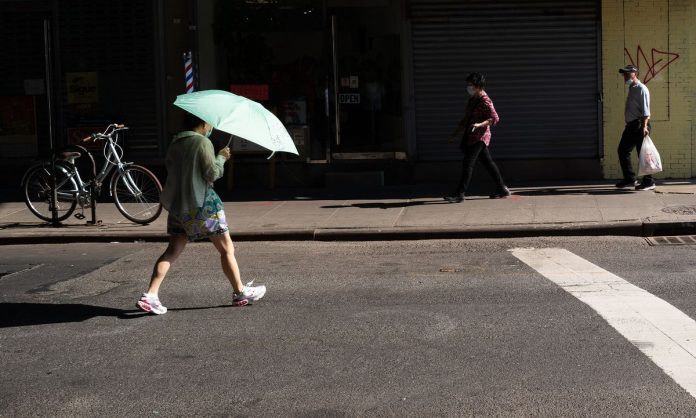Cities can be miserable during heat waves. All that concrete and asphalt soaks up the sun’s rays, pushing temperatures up even further. Tall buildings can block cooling breezes. Exhaust from cars and air-conditioners just adds to the swelter.
This is known as the urban heat island effect: A large city’s built-up environment can make it 2 to 5 degrees Fahrenheit warmer than the surrounding countryside during the day and up to 22 degrees warmer at night. That extra heat is becoming a serious public health problem. On average, 650 Americans die each year from heat-related causes, the Centers for Disease Control and Prevention estimates, and global warming is only expected to make things worse.
In recent years, some urban planners have been seeking out creative strategies to combat the heat island effect to provide relief and prevent more people from dying during brutal hot spells. “Cities need to realize that they have the power to change their own weather,” said Brian Stone, Jr., a professor at Georgia Tech’s School of City and Regional Planning.
Here’s a look at a few of the more promising ideas that cities around the world have been pursuing to try to beat the heat.
1) Bring Back the Trees
This summer in Dallas, where a persistent heat dome has sent temperatures soaring past 105 degrees, volunteers have fanned out around the low-income neighborhood of Oak Cliff, working with residents to plant 1,000 new trees around schools and homes.
Trees don’t just provide much-needed shade for a sweaty city. The water evaporating from their leaves can cool a neighborhood by a few degrees during the hottest periods. Tree leaves also absorb and filter local air pollution — a crucial benefit, since heat waves can worsen urban smog, sending people to the hospital with asthma and other illnesses.
One downside is that trees can be costly to maintain, a concern for budget-strapped cities. So, in Dallas, the groups spearheading the planting effort — the Trust for Public Land, the Texas Trees Foundation and the Nature Conservancy — are using health, environmental and socio-economic data to figure out where planting new trees would provide the most benefit.
It will take more than just a few trees to cool down Dallas. “We’re probably talking a quarter-million new trees if we really want to move the needle,” said Laura Huffman, state director of The Nature Conservancy in Texas.
Other cities have their own ideas for promoting urban vegetation: Seattle now encourages developers to add rooftop gardens or even walls covered by vegetation to new building projects. London recently conducted an audit of its central business districts and identified over 10 million square feet of space that could be converted to rain gardens, green roofs and green walls.
2) Let the Wind Blow
In the industrial city of Stuttgart, Germany, refreshing breezes are both scarce and valuable. The city sits in a river valley basin, surrounded by steep hills that can trap both heat and polluted air over the region. It’s a potentially lethal combination during the hotter months.
In response, Stuttgart has created a number of ventilation corridors throughout the city: wide, tree-flanked arterial roads that help clean air flow down from the hills at night to cool the city. Officials have also restricted new buildings from going up on certain hillsides in order to keep the air moving.
Some experts are skeptical that this strategy will work for every city because a lot depends on local weather patterns and geography. But China is becoming interested. Beijing and Xian are looking to create their own ventilation corridors, studying local wind patterns and strategically placing parks or lakes instead of buildings along key pathways so that the cooler breezes can flow freely.
3) Paint Roofs Whitec
One big reason that cities are so much hotter than rural areas is that they are covered by dark roofs, roads and parking lots that absorb and retain heat. In recent years, many urban planners have sought to replace those dark surfaces with lighter, more reflective materials.
Through its CoolRoofs Initiative, New York City has already painted more than 5 million square feet of its roofs with a reflective coating. Los Angeles is replacing some of its dark asphalt roads with brighter materials.
In theory, a big push by cities to add more green space and reflective building materials could save lives: One recent study, led by Dr. Stone of Georgia Tech, estimated that these two techniques could potentially offset much of the projected increase in heat-related deaths from global warming in Philadelphia, Atlanta and Phoenix by 2050.
But the effectiveness of cool roofs can vary from city to city. One 2014 study, led by Matei Georgescu of Arizona State University, found that the strategy, if widely adopted, could cut temperatures by several degrees in cities like Washington or New York. But in Florida, reflective materials would have a smaller impact and could potentially reduce local rainfall.
“Every city is different, and there’s still more work to do to understand the different trade-offs,” Dr. Georgescu said.
Some cities can’t afford to wait. Tokyo, which has suffered a record heat wave this month, is desperate to cool off ahead of the 2020 Summer Olympics. The city has already added new porous asphalt that can retain more water and new coatings that can reflect heat across more than 50 miles of roadways, including the planned marathon route. The hope is that these materials can cut road surface temperatures by 10 degrees or more. Even that may not be enough: Some researchers have already suggested moving the marathon out of Tokyo entirely for the athletes’ safety.
4) Get People to Cooling Centers
When dangerous heat waves arrive, access to air conditioning can be a matter of life or death. That’s why more and more cities are setting up public cooling centers to offer relief for those who might lack cool air at home, like low-income residents or the homeless.
But public health experts say that setting up cooling centers is only half the battle: the other half is getting people to them. One recent survey of Detroit, Philadelphia, Phoenix and New York found that public cooling centers were often poorly publicized or difficult to access by public transportation. Some residents were reluctant to leave their homes during heat waves or mistakenly thought that cooling centers were just for homeless people.
“There’s this large social and behavioral component to heat waves that doesn’t get nearly enough attention,” said Jalonne L. White-Newsome, a senior program officer at the Kresge Foundation who led the study.
Some of the best strategies for dealing with heat waves, Dr. White-Newsome found, were often low-tech: In Philadelphia, many neighborhoods have designated block captains who will check on older residents during a heat wave. “When a disaster hits, having a cohesive social network is what’s going to keep many people alive,” she said.
5) Prepare for Deadly Blackouts
The ultimate nightmare scenario during a heat wave is a widespread blackout that leaves millions of people without electricity for their fans or air-conditioners. That combination was a major health risk in Puerto Rico after Hurricane Maria.
When temperatures soar, the electric grid comes under serious strain. Power lines also start sagging in the heat and can short out if they touch the ground or nearby foliage. Parts of Southern California lost power this month after temperatures reached 110 degrees, and scientists warn that global warming could increase these risks in the future.
Some possible solutions? Smarter grids and new forecasting tools could help electric utilities prepare for heat waves, using electronic controls to precool buildings before temperatures peak in the afternoon and then turning down nonessential appliances when energy demand surges, said Santiago Carlos Grijalva, a professor of electrical engineering at Georgia Tech.
We might also make our buildings more resilient. David Sailor, a professor of urban planning at Arizona State University, has been exploring the possibility of using advanced materials that can essentially absorb excess heat by melting, which in turn helps keep interior spaces at a comfortable temperature. These phase-change materials could reduce the energy needed for cooling — or help prevent homes from overheating in the event of a blackout.
Dr. Sailor recently got a taste why this technology could prove invaluable. A few hours after we spoke last week, the cooling system in his campus building in Tempe, Ariz., broke down. Within 90 minutes, he said, temperatures inside spiked to 85 degrees.





























